
Say you’re ready to launch your ecommerce business and you’ve settled for Shopify as an ecommerce platform. Now you’re confused about which of the Shopify pricing plans to choose. That’s normal for a beginner who wants to be sure of choosing the best pricing plan.
The fear of making the run wrong choice is always there hence the need to guard against it. Don’t worry, that’s what I’m here to help you with.
I welcome you to this ultimate guide where I will discuss with you Shopify pricing plans. The goal is to keep you informed so as to make the best choice base on the type of Shopify store you plan to run. This guide will cover the following:
- Shopify pricing plans
- Features
- Pros and Cons
- Relevant factors revolving around Shopify pricing plans
- Extra Shopify costs to take note of
- Frequently asked questions on Shopify pricing plans
Before we head to details, let’s look at the basics.
What is Shopify?
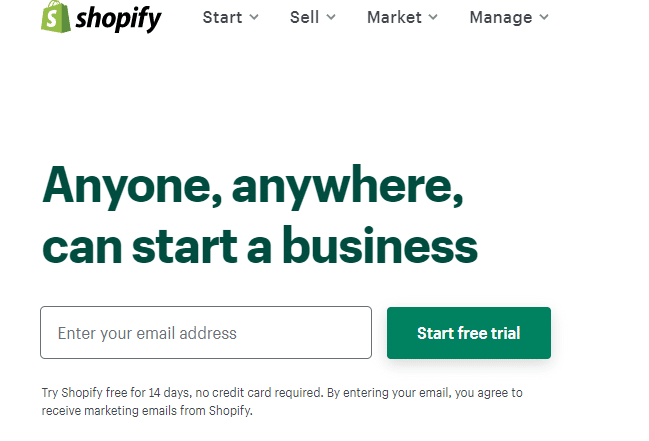
Shopify is an all-in-one robust e-commerce platform where you can set up your own online store. It is designed to help you start, run, and grow your business. As a leading ecommerce platform, it powers over 1,000,000 businesses worldwide.
There are over 70 professionally designed themes that make it easy for you to customize your store without writing a single line of code. As a website builder, you can host build any kind of ecommerce website with it.
A full-featured content management system is attached to your online store.
To prove that it’s a force to reckon with in the ecommerce world, Shopify made a revenue of $714.3 million in Q2 of 2020. 71% of the revenue came from new stores that were opened under the period in review.
What are Shopify pricing plans?
Shopify pricing plans are different monthly or yearly subscription plans you need to pay to keep your online store up and running on Shopify.
That’s the first choice you make after you have decided to start your ecommerce business on Shopify.
Now let’s go into details.
Shopify has 5 different pricing plans from which you can make a choice either as a beginner or someone who is already in the game of selling online.
These pricing plans have different features they offer and the amount you need to pay monthly or yearly to run your online store on them.
The higher the plan, the more advanced features you enjoy.
Let’s take them one after another.
1. Shopify lite ($9/month)
Shopify lite is the least plan that Shopify offers. You can’t build a full-fledged online store with this plan but you can sell products on your website or blog.
Be it Tumblr WordPress, SquareSpace, or any other content management platforms, selling on your website is just a click with the Buy Button which Shopify lite offers.
Receiving payment for products purchased is simplified with the Sale on Point app which allows you to receive payment via Android or iOS devices. You can even decide to receive payment in person.
Basic features of Shopify lite
Buy Button: Designed for customers to make purchases from your store.
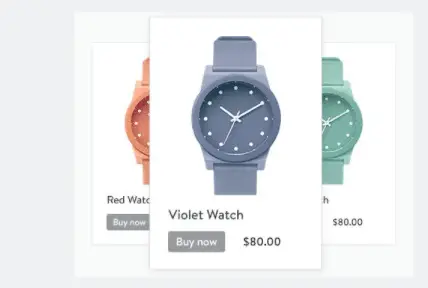
Point of Sale app: This is a kind of made easy payment that allows you to accept payment via IOS and Android.
Pros of Shopify lite
- You can create custom orders and send them directly to your customers.
- It allows you to sell on your blog or website.
- It’s cheap.
Cons of Shopify lite
- You can’t run a full-fledged online store.
- Some basic integrations with social networks like Pinterest and Twitter are lacking.
2. Basic Shopify ( $29/month)
This is the second least Shopify pricing plan in terms of a monthly subscription. Basic Shopify is the plan that best suits beginners who just want to try out ecommerce business to see If it’s for them.
Its subscription goes for $29/ month.
Let’s see some basic features it offer.
Basic features of Basic Shopify
Integration: You can integrate any of the over 1400 apps on Shopify into your store for various functionalities.
Sell anywhere: Sell your products on any platform you like including Facebook, Instagram, Amazon, Aliexpress, or even with the buy button.
Different payment methods: You have various payment methods through which you can receive money. E.g Paypal, Stripe, 2checkout, Authorize.net, etc.
Build an online store: Unlike Shopify lite, you can build a full-fledged online store with all the tools and features you need to succeed in it.
Pros of Basic Shopify
- Up to 64% shipping discount if from DHL express and USPS.
- Print your shipping labels yourself.
- Sell any kind of product you want without restriction.
- Create coupons and discounts for your customers. Coupons are codes your loyal customers can use to make purchases from your store at a lower price.
- The discount could be a reduction in the price you offer to customers that bought a large unit of products in your store.
- You’ve access to Shopify APIs which makes it easy for you to connect to third-party apps.
- Offers customer support through livechat, email, or phone.
- Speedy checkout.
Cons of Basic Shopify
- Only 2 of your staff can have access to your Shopify store.
- Selling of products, order fulfillment, and stock inventory is restricted to only 4 locations.
- Doesn’t support professional report.
- 2.0 % transaction fee is deducted for payments received through third party payment gateways.
- 2.9% + $0.3 charges for payments received through online credit card.
- For in-person credit cards, a fee of 2.7% applies.
- Basic Shopify plan doesn’t integrate with your shipping account.
- Doesn’t support advanced report builder.
3. Shopify ( $79/month)
This’s the next plan in price after Basic Shopify.
It is also the mid-range of Shopify pricing plans. It becomes a plan to aim for after you’ve already test run ecommerce business with Shopify basic plan and it turned out good.
If you make a profit of $5000 consistently through dropshipping or selling your products, then this plan is for you. This’s because as your business grows, you already have plans to scale it with more ecommerce features.
Basic features of Shopify Plan
Sell anywhere: With Shopify plan, you can sell anywhere you want. Be it on Amazon, Aliexpress, Amazon, Facebook, Instagram, etc.
Online store: Design and build your online store with awesome features that this plan offer.
Integration: Shopify has 1400+ apps that can integrate with your store for additional functionalities.

Multiple payment methods: Accept payment through Stripe, Paypal, Authorize.net, 2checkout, etc.
Marketing platforms like Facebook and Google are integrated into this plan.
Pros of Shopify plan
- Speedy checkout
- Access to Shopify APIs
- Offer coupons and discounts to your customers.
- 24/7 customer support.
- Shopify fulfillment network is fully integrated.
- Print shipping labels for your customers.
- Up to 5 of your staff can have access to your Shopify account.
- Ship products, stock inventory and sell your products in 5 different locations.
- Professional report is supported.
Cons of Shopify Plan
- Your shipping account is not integrated into your Shopify account.
- Lacks advanced builder report.
- 2.6% + $0.3 are charged for transactions carried out with online credit card.
- For payments received through in-person credit card, 2.5% is charged.
- A transaction fee of 1.0 % is charged for payment made through third-party payment gateways.
4. Advanced Shopify ( $299/month)
Advanced Shopify is the next to the highest Shopify plan.
It costs $299/month. This Shopify pricing plan is for merchants who have already scaled their business but want to keep improving with more features.
For businesses that are steadily making $10,000 profit on a monthly basis, this might be a plan to consider.
Although it is expensive, its low transaction fee and more advanced features aimed at scaling your store compensate for that.
Basic features of Advanced Shopify
- Just like Shopify and Basic Shopify, advanced Shopify integrates with many apps on Shopify. E.g Salesforce, Google Analytics, Livechat, Printiful, Oberlo, etc.
- You can sell on Facebook, Instagram, Amazon, Aliexpress, Messenger, or even with the Buy Button.

- Connect to third-party apps using Shopify APIs.
- Receive payment through different third party payment gateways.
- You can create, design, and launch your ecommerce store.
- Your shipping account is integrated into your store.
- Shopify fulfillment network is completely connected to your store.
Pros of Advanced Shopify
- Fast and reliable checkout is guaranteed.
- Sell any kind of product you want. No restrictions.
- Shipping rates are calculated by the third party.
- O.5% transaction fee is charged.
- Offers email, Live chat, and phone call support.
- 74% reduction in shipping price from USPS and DHL express.
- You can make use of the Point of Sale app for in-person payment.
- Up to 15 staff can have work in your store.
- Stock inventory, sell and fulfill orders in 8 different locations.
Cons of Advanced Shopify
- It is expensive.
- It charges 2.4% + $0.3 for online credit card transactions and 2.4% charges for in person credit card transactions.
5. Shopify Plus ( Starting from $2000/month)
Shopify plus so far is the highest pricing plan on Shopify. It is exclusively designed for large businesses and companies that record large volumes of sales every now and then.
Shopify created this plan to empower large businesses to use the latest and modern ecommerce features, add ons, and tools to run their businesses.
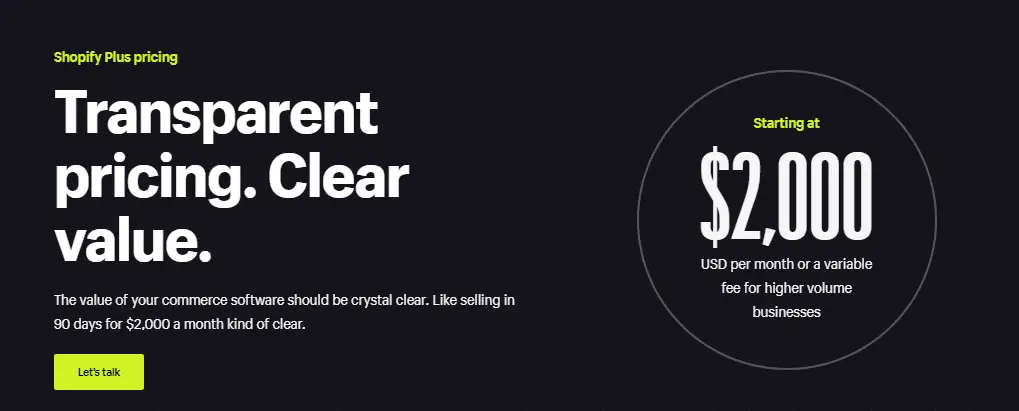
These large businesses have the choice to customize, tweak their designs to suit their stores. Starting with $2000 per month, you can subscribe to Shopify plus.
This is quite expensive but hey, over 7,000 companies trust it to run their ecommerce business. Let’s look at the features of this powerful plan.
Basic features of Shopify Plus
- Take your ecommerce business internationally by creating different stores in different languages.
- Access to ecommerce project management tools to turn manual tasks into an automated workflow.
- Has a robotically driven fulfillment center to handle large volume of orders. This is key for large businesses that run dropshipping business.
- Explore all the 20 sale channels on Shopify so as to skyrocket your sales.
Pros of Shopify Plus
- Work with Shopify certified partners to grow your business into a global brand.
- Sell in over 130 global different currencies.
- Launch an unlimited number of stores.
- Monitor orders and sales from different stores in a single dashboard.
- Access to Shopify pay to ensure one-tap checkout for your customers.
- Avalara Ava tax handles your per sales tax through automation to save you stress and time.
- 24/7 fast and quality customer support through livechat, email, and phone.
- Choose from 100+ payment gateways. E.g Google Pay, Amazon Pay, PayPal, Stripe, 2Checkout, Authorize.net, etc.
Cons of Shopify Plus
- It’s very expensive.
- $250 is paid monthly for the tax services offered by Avalar Avatax.
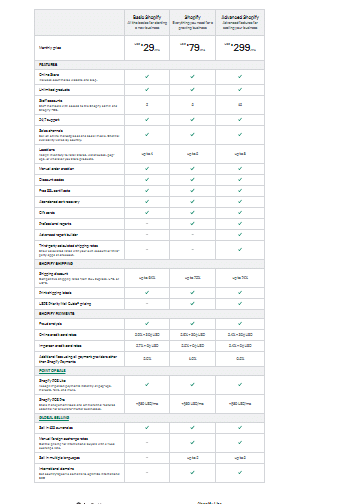
Now that you have known the 5 different Shopify pricing plans, let’s look at things to consider before choosing a Shopify pricing plan.
Factors to consider before choosing a Shopify pricing plan
You don’t just choose a Shopify pricing plan. Otherwise, you make the mistake of choosing a plan that isn’t for you at a particular time. There are factors that will inform such a decision.
1. Type of ecommerce business to run
Some people just jump to any plan because at least there is a 14-day free trial. What if the trial expires only to realize that the pricing plan you’ve chosen isn’t suitable?
The question should be; what kind of ecommerce business do I want to start? Do I want to start small and see how it works for me?
Do I want to launch a large ecommerce business straight up no matter the risk that comes with it? Could it be that I’m not ready to run for a full-fledged online store but just want to use Shopify to sell on my website or blog? These are the questions you need to answer.
2. Level of experience
Some people haven’t run an ecommerce business. To such people, they want to give it a trial base on what they have learned on how ecommerce works.
They are prepared to make mistakes through the process and learn from them.
Another set of people are those who are already in ecommerce business either as store owners or drop shippers.
For them, they want to switch to Shopify as an ecommerce platform. For a beginner with little or no experience, it is expected that you start with a lower plan and gradually upgrade to a higher plan.
3. Budget
You may prefer a plan because of the awesome features it offers. But it’s your budget that’ll decide if it’s what you should go for.
I mean the budget to pay for the monthly subscription and other extra Shopify cost pending when you will be making a reasonable amount as profit.
4. Features
As Shopify pricing plans differ, so are the features they offer. The higher the plan the more advanced features you enjoy.
It’s important you take your time to check out all the features each of the Shopify pricing plans offer.
Compare them side by side against your requirements and the kind of ecommerce business you plan to run before making your final decision.
With that being said, it’s time we discuss relevant factors revolving around Shopify pricing plans that you need to know.
This is to ensure that you get clarified on questions that bother you as it concerns Shopify pricing plans.
Discounts on Shopify pricing plans
We all want to get discounts when we purchase products of large quality. That’s normal. The same applies to software. Shopify isn’t an exception here. It offers discounts too. Its discounts are of 2 types:
- 10% discount for 12 months upfront subscription.
- 20 % discount for 24 months upfront subscription.
Let me break it down.
Take for instance you chose basic Shopify as a plan and paid for 12 months upfront.
Let’s do the maths.
Basic Shopify costs $29/month.
12 * 29 = $348.
10% of $348 = 34.8
348 – 34.8 = 313.2.
This means that at a discount of 10% for Basic Shopify plan paid for 12 months, you pay $313.2 instead of $348.
What if you decide to pay for 24 months for the same basic plan?
Here is it:
24* 29 = $696
20% of 696 = 139.2
696 – 139.2 = 556.8
At a discount of 20% for 24 months subscription on Basic Shopify, you pay $556.8 instead of $ 696.
Shopify transaction fees
I see a lot of Shopify merchants complain about Shopify transaction fees and its effect on their revenue.
Shopify transaction fees are small deduction Shopify make when you received payment on your store through third party payment gateways.
By that, I mean non-Shopify payment platforms like Stripe, Paypal, Amazon Pay, 2Checkout, Authorize.net, etc.
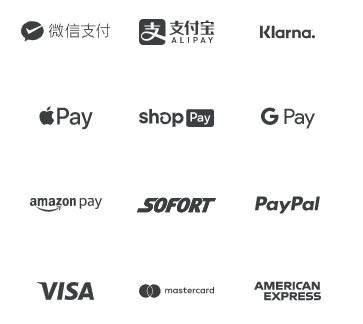
These fees are charged by Shopify for the service they offer you which is processing payments on your behalf. They vary according to plans. The higher the plan, the lower the transaction fee.
5 Shopify Pricing Plans and there transaction fees
- Shopify lite – 2.0 % per transaction
- Basic Shopify – 2.0 % per transaction
- Shopify – 1.0 % per transaction
- Advanced Shopify – 0.5 % per transaction
- Shopify Plus – O.15 % per transaction
How do I avoid transaction fees on Shopify?
Some store owners on Shopify especially those who record low sales are interested in the answer to this question.
For now, the only way to avoid these transaction fees is to use Shopify payment to receive payments in your store.
It’s 100% free and charges nothing for a transaction. Shopify as a giant in the ecommerce world came up with its own payment gateway to ensure that its customers receive payment easily.
Unfortunately, Shopify payment isn’t available in all regions. That’s a big downside of it that some merchants aren’t happy with.
It’s available only in the following countries: Canada, Germany, Ireland, Japan, New Zealand, Australia, Singapore, Spain, the United Kingdom, Hong Kong, and the United States.
Shopify credit card charges
Just like you pay transaction fees on Shopify, there is also credit card charges to take care of.
Shopify charges these fees to allow you to accept payment from major credit cards like Visa, MasterCard, Verve, etc.
These credit card charges vary according to the Shopify Plan you subscripted to. The higher the plan, the lower the credit card charges.
Let’s look at them below.
Shopify lite: 2.9% + $ 0.3 per online credit transaction. 2.7% if it was done with the Point on Sale app.
Basic Shopify: 2.9% + $0.3 per online credit card transaction. 2.7 % per in person credit card transaction.
Shopify : 2.6% + $0.3 per online credit card transaction. 2.5% per in person credit card transaction.
Advanced Shopify: 2.4 % + $0.3 pee online credit card transaction. 2.4 % for in person credit card transaction.
Shopify Plus: The credit card charges for Shopify plus vary by country. You have to contact the customer service representative of Shopify to know the rate for your country.
How can I avoid credit card charges?
The only way to avoid it is not to accept payments using credit cards in your store.
But that will be a big turn off for your customers who mostly will make a purchase using major credit cards from Visa, MasterCard, Verve, etc. It might lead to a decrease in the number of sales you normally record.
Can a credit card charge be reversed when a refund is made to the customer?
In an event that it is established that a refund was made to a customer, the credit card charges will be reversed if the refund was issued in Austria, the United States, and Sweden.
Does Shopify monthly plan subscription cover the transaction and credit card charges?
No, Shopify’s monthly subscription is the fee you pay to keep your store up and running. Without it, your store won’t exist. It is different from transaction and credit card charges which are deducted when you receive a payment on your store.
What about other alternative ecommerce platforms like BigCommerce and WooCommerce, what are their monthly plans, transaction fees, and credit card charges like?
That’s a good idea to compare Shopify in this regard to follow ecommerce platforms. After all, Shopify isn’t the only ecommerce platform though it is the most popular. But it’s cool you have other choices to make.
BigCommerce is a close competitor to Shopify. Both are all in one ecommerce platforms. It has 4 different pricing plans.
BigCommerce pricing plan
- Standard – $29.99/month
- Plus – $71.95/month
- Pro – $ 269.96/month
- Enterprise – Negotiable
What about its transaction and credit card fees?
It is a good thing to know that BigCommerce doesn’t charge you any transaction fee. But they automatically upgrade you to a higher plan if you record a certain number of sales in a year. This is what some store owners won’t want to hear.
It means that you’re forced to upgrade to a higher plan base on your success rate in sales on their platform.
Shopify doesn’t force you to upgrade to a higher plan no matter the number of sales you record in 12 months.
Also, BigCommerce charges 2.9% + $0.3 to process payments received by store owners through debit and credit cards. This charge is the same for all 4 pricing plans for BigCommerce.
Woocommerce as another alternative to Shopify
WooCommerce is also compared to Shopify. It is a self-hosted ecommerce platform that does charge any monthly subscription plan. However, 2.9% +$ 0.3 is charged for debit and credit cards issued in the United States.
An additional 1.0/% is charged for cards issued outside the US.
This means that for debit and credit cards issued outside the US which was used to receive payment on your WooCommerce store, 3.9% + $0.3 is charged per transaction.
While it may be cheaper to run a store on WooCommerce compared to Shopify, one must know the following about WooCommerce.
- You have to take care of the security, backups and updates of your store.
- The cost of hosting your store is on you.
- Since it is a WordPress plugin, you are responsible for the installation and activation of other WordPress plugins you will need to run your store.
For me, WooCommerce isn’t for a beginner who hasn’t managed an online store. Why? It will be difficult for such a person to self-host an ecommerce store, add and manage the necessary WordPress plugins to get it running.
Let’s move further.
Extra Shopify costs to take note of
It doesn’t end at paying for the monthly subscription for the Shopify plan you have chosen. That’s is just the basic. There are other costs you should bear in mind and make budgetary provisions. These costs are key to running a successful Shopify store.
1. Domain
Before your store can go live, you need to purchase a domain name for it. This is the name customers will search to locate your store. There 2 ways in which you can get a domain name for your store.
- Through Shopify
- Third-party domain name companies
You can purchase a domain name from Shopify starting from $11/ year. Shopify automatically connects the domain to your store thereby saving you the time of doing it manually.
Alternatively, you can buy it from a third-party domain name company like GoDaddy and do the manual configuration yourself.
2. Shopify apps
There are over 1,400 apps on Shopify. This is excluding other third-party apps you can connect with using Shopify APIs. You will need some of these apps to add more advanced features to your store.
While some are free, the robust ones that you need to scale your store aren’t free. Apps like Oberlo, Printiful, Salesforce will be useful to you. Be it in dropshipping or selling your own products.
3. Themes
Theme is the next thing that comes to mind after you have paid for a plan. Just like you design your mortar and brick store, themes are the beauty of your online store. It gives it an outlook that is perfect and befitting for your niche.

Shopify has a lot of themes in its theme store. A few are free while many are not. It even connects with a robust and advanced theme like Debutify Shopify theme which has more advanced features, tools, and add ons.
4. Technical assistant
No matter how tech-savvy you’re, you will surely need the services of Shopify experts. Such need may arise when your store begins to record a high volume of traffic and sales. You will have the need to hire the services of a Shopify technical assistant to help install and set up apps that are a must for the type of store you operate.
FAQs on Shopify pricing plans
Before I wrap up, let’s look at some common questions people ask on Shopify pricing plans.
1. Is Shopify Pricing plan free?
No, Shopify Pricing plan isn’t free. You have to choose a plan from the 5 different Shopify pricing plans.
Below are them once again:
- Shopify Plus – starting from $2000/month
- Advanced Shopify – $299/month
- Shopify – $79/month
- Basic Shopify – $29/month
- Shopify lite – $9/month
Each of the plans offers a 14-day free trial.
2. Is Shopify too expensive?
Yes and No. Yes, when compared to other ecommerce platforms like WooCommerce that doesn’t charge transaction fees and monthly subscription.
No, when compared to the value it offers. Shopify is an all-in-one ecommerce platform that is beginner-friendly. It also offers you all you need to succeed as a merchant on its platform.
3. What about Shopify plus pricing?
Shopify plus is the highest plan any merchant can subscribe to on Shopify. It is a plan designed for large businesses and companies which empowers them to run their stores as they like. It’s pricing plan is negotiable but starts from $2000/ month.
4. What are the pricing plans of BigCommerce?
BigCommerce is another ecommerce platform that competes with Shopify. Its pricing plans are of 4 different types which include;
- Standard – $29.99/month
- Plus – $71.95/month
- Pro – $ 269.96/month
- Enterprise – Negotiable
Wrapping Up
That’s it with Shopify pricing plans and other relevant things you need to know about it. I hope by now you have gotten the basic knowledge you need to choose a suitable pricing plan.
Compare your requirements in a Shopify store against the features discussed here. That will guide you towards making the best choice. Bear in mind these two things:
- Shopify plans vary with features.
- You can always upgrade to a higher plan.
It’s now up to you to make a choice. Don’t forget to go first with the 14- day free trial of any plan you choose.
This is to be sure that you’re okay with it before paying for a monthly, annual, or biennial subscription.

![What Percentage Does eBay Take From A Sale A Seller Makes? [ Explainer]](https://www.depreneurdigest.com/wp-content/uploads/2022/06/What-Percentage-Does-eBay-Take-From-A-Sale-150x150.png)
![Does Aliexpress take PayPal? [ Explainer + Other Payment Methods]](https://www.depreneurdigest.com/wp-content/uploads/2022/06/Does-Aliexpress-take-PayPal-150x150.png)
![Shopify Affiliate Program: A Complete Beginners Guide[2021]](https://www.depreneurdigest.com/wp-content/uploads/2021/03/shopify-affiliate-program-150x150.png)